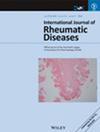The Role of Abatacept on Inflammation and Fibrosis in Hypochlorous Acid-Induced Fibrosis Mice
Abstract
Aim
To investigate the effect of abatacept in the hypochlorous acid (HCLO)-induced fibrosis model and to analyze changes in immune cell fractions within the abatacept-treated early diffuse systemic sclerosis (SSc) cohort.
Methods
Fibrosis was induced in BALB/c mice by subcutaneous injection of HCLO, and abatacept was injected intraperitoneally on alternate days starting on day 28. After 6 weeks, we assessed the pathological changes, inflammation, myofibroblast activation, and the percentage of ICOS in CD3+ T cells. Potential pathways affected by abatacept were also investigated. Finally, we analyzed immune infiltration and multiple scores in early diffuse SSc patients and in the skin and lung tissues of the HCLO model after abatacept administration.
Results
Abatacept significantly decreased the proportion of M2 macrophages in the abatacept-treated HCLO model and the inflammatory improver subset of SSc patients. Furthermore, abatacept reduced CD28 signaling, the inflammation-related pathway, and the ICOS expression on CD3+ T cells in HCLO mice. In the inflammatory subset of SSc patients and HCLO mice, microenvironmental and immune scores tended to decrease after abatacept treatment. Unexpectedly, abatacept had no effect on skin or lung collagen content in HCLO mice. The number of T cells and myofibroblasts was not reduced in the abatacept-treated HCLO group.
Conclusion
Although abatacept did not improve skin and lung fibrosis in the HCLO mice, it reduced the immune response signature and the proportion of M2 macrophages. These findings suggest that further research is needed to assess the therapeutic value of abatacept in SSc patients and preclinical mouse models.


 求助内容:
求助内容: 应助结果提醒方式:
应助结果提醒方式:


